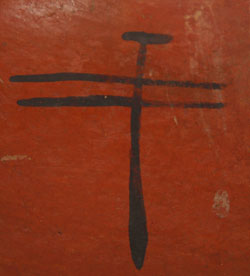Zuni Pueblo Red Jar with Plumed Serpent Attachments [SOLD]
+ Add to my watchlist Forward to Friend
- Category: Historic
- Origin: Zuni Pueblo, SHE-WE-NA
- Medium: clay, pigment
- Size: 8” tall x 8-3/4” diameter
- Item # C3328D SOLD
White and black decoration on red slip was a short-lived pottery typology that started around 1890 and continued only until around 1920. There are prehistoric precedents for such a style primarily in St. Johns Polychrome as well as some pottery excavated at the Zuni Pueblos of Hawikuh and Holona. It is quite possible that potters were influenced by these prehistoric examples and chose to recreate it but it was short lived.

The rarity of examples is seen in the collections made by Stevenson between 1879 and 1885 in which there is only one vessel of the type. Later collections, made in 1899, 1903, and 1910 contain numerous examples, an indication that more potters started making it by the end of the decade of the 1890s.
Neckless jars of the style of this one seem to appear in the late 1800s and early 1900s collections and were perhaps a simpler way of construction than the standard olla shape vessels. The Plumed Serpent additions to this jar could have been for the purpose of creating a ceremonial vessel or could have been for imitating a ceremonial vessel in an attempt to find a favorable purchaser. Ceremonial vessels generally are designed with water creatures such as water serpents, dragonflies, tadpoles, frogs, etc. This one is decorated with what may be dragonflies. Early collectors of pottery were intrigued with ceremonial items and many pseudo-ceremonial ones were made to appeal to this group.
Condition: the jar is in very good condition with sufficient ethnographic wear to provide interest. The plumes on both serpents are damaged and the horns are missing, but sufficient serpent's features are still visible.
Provenance: from the collection of a gentleman from Albuquerque
Recommended Reading: The Pottery of Zuni Pueblo by Lanmon and Harlow
- Category: Historic
- Origin: Zuni Pueblo, SHE-WE-NA
- Medium: clay, pigment
- Size: 8” tall x 8-3/4” diameter
- Item # C3328D SOLD



